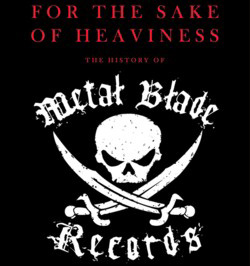 FOR THE SAKE OF HEAVINESS – THE HISTORY OF METAL BLADE – Brian Slagel and Mark Eglinton (BMG)
FOR THE SAKE OF HEAVINESS – THE HISTORY OF METAL BLADE – Brian Slagel and Mark Eglinton (BMG)
Just as Neat and Heavy Metal Records powered the New Wave Of British Heavy Metal, Metal Blade and Megaforce were the two labels that fuelled the explosion of U.S. acts that followed. Brian Slagel was the head of Metal Blade – in fact, for several years he WAS Metal Blade, operating out of his bedroom in his mum’s house – and with little money or guidance but with friends and blind faith he turned a glorified hobby into a major player on the American metal scene. As a one-man band he poured all his energies into making Metal Blade a success, and in 1985 he notes “I was still in such a state of immersion [in the day-to-day operation] that I didn’t realise I had an actual career.”
Most metal fans have an epiphany, and for Slagel it was hearing ‘Machine Head’ as an eleven-year-old living in southern California, followed swiftly by ‘Sabbath Bloody Sabbath’. His decline from normality to metallurgy took the usual path – gigs, fanzines, working in a record store – until he decided to launch his own label, the name coming from his love of axes and ice hockey (hence the blade) and the (obvious) need to include the word metal.
He tells his story with little frills, being naturally proud of his successes and candid about his mistakes, in particular when he stuck steadfastly to vinyl because of his personal love of the format: as CDs swept the board and shops stopped stocking LPs more and more of the label’s output was returned, causing a major cash flow problem and resulting in a warehouse chock full of records. Of course, Slagel has the last laugh, as twenty years later the same returned product would make him a tidy profit as vinyl made its inevitable comeback.
Bands come and bands go as Slagel’s discoveries move on to major labels but unlike with other metal indies there seems to be little animosity and everyone remains friends, probably helped by Slagel’s awareness that he couldn’t compete with the big boys and so didn’t even try. His forté was (and still is) the underground, and his love of the music and desire to help acts move up the ladder not only shines through the text but debunks the myth that such labels were only ever in it for the money.
An honest and very enjoyable account, for which Slagel and his co-writer Mark Eglinton are to be commended.
© John Tucker August 2017
